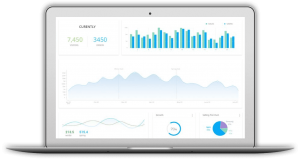Does Your Packaging Manufacturing Plant Know Its Scrap Rates? In which stage of the scrap reporting are you?
Alongside downtime, scrap rates (or waste) are a major concern for any plant manager, especially in the packaging industry. Although the numbers vary greatly from manufacturer to manufacturer, when we look at in-line production facilities (where all machines are connected in series), scrap rates of 15-25% are completely normal. During this time, the plant is consuming energy, raw material and equipment uptime. This means that for every 4 hours of production, the company is throwing material, energy and equipment time in the bin. The struggle to reduce these numbers is hard, daily and constant, and only one thing is for sure: you cannot do it without reliable production numbers, just by looking in the rearview mirror.
Although almost every piece of equipment has integrated counters for rejected parts, few companies collect this data automatically to transform it into intelligence. As a result, they end up depending on manual notes, the nightmare of information reliability.
Anyone who has spent a few hours on the factory floor knows: the life of an operator is not easy. The routine of production, quality control, and tool change is intense, and on top of that, we add notes. It’s like asking a chef to take table orders.
Generally, from inside the air-conditioned office, it seems simple to put one more note for the operator to perform, and we end up creating unrealistic expectations of manual data collection in the factory. “It does not take 10 seconds to do it. They must do it!” And then, there it goes – one more piece of data that the operator must point to hourly, at the end of the shift or at the end of the production order. Sometimes it even works…for a week, maybe a month. Then there are missing notes.
The result, in this case, is usually a manager putting even more pressure on someone who should be concerned about producing good parts, not generating information.
To illustrate how complicated it is, try a thought experiment with an analogy to our diet. Imagine that you go to a nutritionist and she asks you to write down how many meals you have had at the end of each day. It does not seem difficult, after all, simply stop for 5 seconds and write a number on a calendar or a piece of paper. You then return to the nutritionist, with everything written down and she congratulates you on your discipline.
A week with everything written down. However, to help you further she needs more information. She now needs to know what time you have each meal. Still not difficult. It’s another 5 seconds of pointing . After that, she asks you to write down what you ate at each meal, in addition to the previous data. Then she asks for the weight of each meal. When looked at in perspective, we would spend no more than 1-2 minutes total on the notes. What’s that in a 24-hour day? Nothing, right? However, who do you think can do this for more than 3 days in a row? If you can think of someone, hats off to them. 90% of people would fail on the first day. Moreover, managing a factory with this quality of data does not seem the best way to go about it.
Therefore, any attitude that decreases the complexity of generating production data (scrap, efficiency and the like) will increase the reliability of the information. Less is more. Of course,
This comes at the expense of “information resolution”, but still, it is usually an interesting trade-off.
Another challenge of manual data collection is counting or weighing scrap every time it is taken out of the factory environment. Even when only one scrap reporting per shift is required, each bag with scrap exiting the factory must be logged somewhere, so that the total volume can be calculated later. In addition, and not least significantly, manual notes do not usually allow corrective action in real time, as we are always looking at the rearview mirror.
Besides the importance of scrap calculation in the optimisation of factory performance, there is another factor that comes into play in some factories: the fiscal question. In some countries, a company must report the waste that was specifically generated for that production order in question, adding even more complexity.
Another use of the scrap note is to calculate the cost of each item. More complex products with more colours or complicated specifications usually generate more scrap and are likely more expensive. Simpler products could have more aggressive prices. Having this information on hand helps you make a more data-driven decision and rely less on intuition. PO note allows this to be calculated.
Here we suggest an increasing scale of scrap rates reporting complexity:
1 – No note: the scrap is calculated by the amount of raw material consumed minus the production made
2 – End-of-shift deadline: all scrap produced is gathered in a specific sector and then counted or (more often) weighed and pointed by shift, without distinction of which part of the process occurred.
3 – Pointing to the end of the shift by machine: identical to the number 2, with the difference that the scrap is separated by machine, allowing us to identify where the greatest source of losses is.
4 – Production order: at the end of each PO the operator must empty all the scrap containers in the production line and point at the ERP or a data sheet production. Usually, an assistant accomplishes this task, which takes away some of the operator’s awareness of how much refuse has been produced.
5 – Hourly statement: at each full hour the scrap should be counted and pointed. Very laborious and only recommended in cases where a dedicated team is available.
6 – Real-time pointing – possible with IoT or MES analytics systems. IoT systems are generally fast to deploy and have relatively low costs but are generally not fully integrated with material handling systems. MES Systems are projects that end up including a consultation and involve every company, as it usually involves relevant investments in hardware and implementation consulting.
Regardless of the type of appointment, it is always important to seek out the new step in the scale, while being aware of the challenges and benefits involved. The challenges of a factory are endless, and you cannot prioritise everything.
However, it is important to stress that we are entering an era in which pointing and analytics systems, which allow data such as scrap, productivity and efficiency (OEE) to be automatically pointed out and analysed, are becoming more and more accessible. With entirely cloud-based infrastructure data acquisition hardware becoming cheaper, the initial investment to automate notes is getting lower and lower.
It is no exaggeration to say that there are no more excuses for not having information in real time or for transforming your operators into data collection machines.





